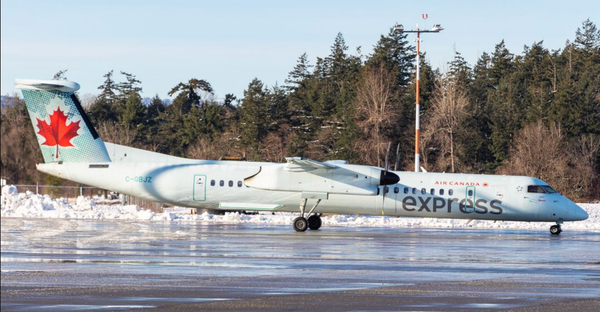If you’re ever listening to the air traffic control (ATC) radio in your IFE screen during your flight or enjoy listening to Live ATC at home, there’s a good chance you’ve heard many different phrases and terms used in air traffic control communications.
Acting as a second language between pilots and air traffic controllers, the language of the sky can be often-time be confusing for first-time listeners and flyers. Here’s a look at some of the most common phrases used in the sky and what they mean.

“Mayday-Mayday-Mayday”
If you hear a mayday call over the radio, a serious emergency is taking place. As the highest level of emergency, mayday calls are reserved for immediate issues threatening the safety of the flight. These issues may be engine failure on a single or dual-engine aircraft, depressurization of the cabin, bomb threats, and more.
With mayday calls, pilots receive priority handling, often-times referred to as “vectoring” from ATC and are sometimes transferred to discrete frequencies where they can communicate directly with emergency responders and air traffic controllers.
Mayday communications also require radio silence on the part of other aircraft on frequency, ensuring that the aircraft in distress has the most resources available to make a safe landing.
“Pan-Pan, Pan-Pan”
Similar to the “mayday-mayday-mayday” distress call, pan-pan is also an emergency radio call. However, the this radio call is a step below a mayday emergency.
When pilots notice some sort of unusual problem with their aircraft that does not present an immediate threat to the life of the passengers and crew onboard, they will often tell ATC that they have a pan-pan situation.
If a multi-engine jetliner, like a Boeing 747 or an Airbus A380 loses one of their four engines, the pilot will typically contact ATC using pan-pan instead of a mayday call. This is because the quadjet can still safely make it to a suitable diversion airport on three engines, thus making the situation non life-threatening for the passengers onboard the 747.
“November Four-Five Charlie Echo Bravo”
When you hear pilots or air traffic controllers using seemingly random words, like November or Charlie, they are most likely utilizing the standardized aviation phonetic alphabet.
As clear communication between the ground and the sky is necessary in maintaining safe operations, the phonetic alphabet was devised to communicate the letters of the Roman alphabet based on the first letter in the world.
For example, November would correspond to the letter N and Charlie would mean the letter C. Using the phonetic alphabet instead of simply saying “N-4-5-C-E-B” when relaying aircraft callsigns or waypoints minimizes confusion, especially with letters that sound familiar, like C and Z.
“Cleared to Kennedy Airport Via Radar Vectors”
One way in which pilots are given navigation directions is by radar vectors. Radar vectors are simply compass headings that pilots are instructed to fly.
For example, when approaching an airport, an air traffic controller may clear a pilot to the airport via radar vectors. The controller would then give the pilot a specific heading to fly, for example, “N45CEB, fly heading 060.”
“N45CEB, squawk 3546”
Squawk codes are one of the most important parts of ensuring a safe flight. When pilots call air traffic control for clearance for their flight, they are assigned a four-digit “squawk code” to input into their aircraft’s transponder.
Squawk codes are used by air traffic controllers to visually track aircraft on their screens during flight. However, if pilots input squawk codes incorrectly into their aircraft transponder, it may prevent air traffic controllers from seeing that aircraft on their screens. This result in many bad scenarios, such as mid-air collision scenarios.
Furthermore, the use of certain squawk codes are restricted to emergencies. The three most well-known codes are 7500, 7600, and 7700. Squawk code 7500 indicates an aircraft has been hijacked, sending out an emergency alert to air traffic controllers.
Squawk 7600 informs air traffic control that the aircraft has lost its communication systems and will need other guidance to safely land.
Lastly, squawk 7700 indicates an emergency onboard. While declaring mayday or pan-pan informs the local controller of the emergency issue, squawking 7700 creates alerts in all nearby air traffic control systems.
“Roger, Wilco"
Two commonly used phrases in aviation communications are Roger and Wilco. Both terms are very similar, indicating that the pilot or air traffic controller has received and understands an instruction.
However, wilco (an abbreviation for will comply) further indicates that the instructions will be carried out. As an example, an air traffic controller might tell a pilot, “N45CEB, report when you have the Cessna in sight.”
The pilot would then respond, “Wilco, N45CEB” to indicate they understand they must inform the controller when they have the other aircraft in sight.
However, using “Roger, wilco” is considered redundant as Wilco already implies Roger, that the pilot understands the directive from air traffic control.
“Affirm/Negative”
This is essentially a pilot’s way to say yes or no. "Affirm" and “negative” are among the most commonly used phrases in the skies. If a pilot asks a confirmation question, such as which runway is in use, the controller will respond with “affirmative” or “negative” depending on if the pilot has the correct information.
As with the phonetic alphabet, the words "affirmative" and "negative" minimize the possibility of misunderstandings compared to simple "yes" or "no" responses.
Pilots and air traffic controllers have many phrases and words that may seem out of the ordinary to the first-time listener. However, using these terms and phrases during communications between the ground and the air is the first step in ensuring smooth and safe flights.
U.S. Carriers Sound Alarm Over Dublin’s ‘Passenger Cap’ and Transatlantic Disruption » Starlux Takes Delivery of First A350-1000 for US East Coast Push » AirBorneo Commences Rural & Regional Flights »
Comments (0)
Add Your Comment
SHARE
TAGS
INFORMATIONAL air traffic control atc safe flights hijacking boeing airbus airportsRECENTLY PUBLISHED
 This Week in Aviation: The 10 Stories That Mattered Most
From major airline developments to aircraft updates and industry shifts, this weekly recap highlights the ten most-read aviation stories from the week of January 04.
INFORMATIONAL
READ MORE »
This Week in Aviation: The 10 Stories That Mattered Most
From major airline developments to aircraft updates and industry shifts, this weekly recap highlights the ten most-read aviation stories from the week of January 04.
INFORMATIONAL
READ MORE »
 NTSB Scrutinizes FAA NOTAM Logic Following Fatal MD 530F Canyon Crash
One week after a private helicopter plummeted into the rugged depths of Telegraph Canyon, the aviation community is reeling not only from the loss of four lives but from the glaring systemic failures it has unearthed.
NEWS
READ MORE »
NTSB Scrutinizes FAA NOTAM Logic Following Fatal MD 530F Canyon Crash
One week after a private helicopter plummeted into the rugged depths of Telegraph Canyon, the aviation community is reeling not only from the loss of four lives but from the glaring systemic failures it has unearthed.
NEWS
READ MORE »
 Air Canada Doubles Down on Regional Strength with Major PAL Airlines Expansion
In a strategic move to fortify its presence in Eastern Canada, Air Canada has officially announced its intent to significantly expand and extend its commercial partnership with PAL Airlines. As of January 8, 2026, the two carriers have signed a Letter of Intent (LOI) that not only secures regional connectivity for the next decade but also introduces a substantial fleet expansion to meet rising demand in Québec and the Maritimes.
NEWS
READ MORE »
Air Canada Doubles Down on Regional Strength with Major PAL Airlines Expansion
In a strategic move to fortify its presence in Eastern Canada, Air Canada has officially announced its intent to significantly expand and extend its commercial partnership with PAL Airlines. As of January 8, 2026, the two carriers have signed a Letter of Intent (LOI) that not only secures regional connectivity for the next decade but also introduces a substantial fleet expansion to meet rising demand in Québec and the Maritimes.
NEWS
READ MORE »



